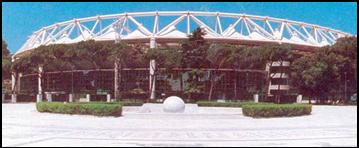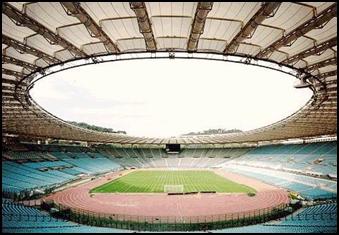|
Now we just had to get inside the gate. We got into the first line we saw only a few meters away. The line was short. Only 10 people long. When we finally got to the ticket taker, he shook his head and clicked with his tongue. "No, No." "Quaranta due (42)." He said, pointing to the number above his head. We were at "diciotto (18)." We should have known by now that there’s no easy way to get into a game in Rome. So off we walked, and walked and walked. Gate forty-two is an entrance on the North side of the stadium, a full half circumference around the massive structure. On the way, we passed by the track and field facility built for the Olympics adjacent to the Stadio Olympico. The circumference of the facility is lined with 20-foot high statues of naked, well-built men, each with the best shapped gluteal musculature that had ever blessed a man’s body. Their pose was reminiscent of Michelangelo’s David, athletic, confident, and contemptuous. They all faced the inner oval where lay the great field of competition for the Olympic competitors. It was obvious that Michelangelo, though long dead when these monolithic, athletic personalities were created, was still very much present. One could sense Italy’s love for the male physique. These were men to be adored, to be cherished and to be dreamt of. We passed by the East center gates 32 to 41. They were all open. People were moving quickly. We realized something. Our $28 dollar-a-piece tickets were not going to be near the midfield area. "If we’re near the goal line, maybe we’re close to the field," I hoped out-loud. Another 50 meters ahead, was gate 42. Behind it was a line formed in a fashion all too reminiscent of the ticket line we encountered about 45 minutes earlier. Next to it were gates 43, 44, 45, 46 and 47. They were all closed. I asked the guy at gate 48. "Can I enter here?" "No!" he responded. He was clear, emphatic. He pointed over to the monstrous line in front of gate 42."La (there)!!" There was no other choice. It was gate 42 or nothing. So it was our fate to wait again, in a line that seemed to go on and on and never seemed to move. While we were waiting, I struggled in Italian to the older gentleman whose shoulder I had become familiar with. He understood immediately the question: "Why was there only one gate open (pointing to the 5 closed gates in that section)?" He shrugged the classical Italian shrug and said,"Chi sa? E’ un mistero Italiano." No one knows. It’s an Italian mystery. We were beginning to understand. There were forces at work at the Stadio Olimpico far greater than my American rational thought. So now, to our seats. Maria thought she saw an elevator. It was wishful thinking. She misread the sign to the first level lavatories. We kept hoping something might be easy. We were always wrong. There’s nothing easy about going to a Serie A football match in Roma. And there was no other way to get into the stadium than to climb the stairs. How many did we face? We couldn’t tell. It was a lot. As we approached the top of the stairs, we were increasingly able to see some of the seating on the opposite side of the stadium. The immense capacity and size of the stadium became more and more real to us. The Stadio Olimpico doesn’t hold 200,000, as does Maracana in Rio De Janeiro, the largest football stadium I’ve ever seen. But after a certain size, does it make any difference? These monsters weren’t created for the intimate experience between field and fan. The designers had one thing in mind: the number of bodies. We had reached the mid level platform and we were very far away from the field, perhaps 150 to 200 feet from the end line, and more than 10 yards behind the goal line. The presence of a track added to the distance. There was a tall, well-reinforced fence. The vision of inmates playing within the prison walls popped into my consciousness. We asked the man next to us, "Dove’ ottontuno (where’s section 181)?" "Li" (right here), he said. We were at the bottom of the 50,000-lira section. "Where’s row 54?" Up there he pointed. "There must be some mistake," was the look we all shared. We paid 50,000 lire for each of our tickets, twice the lowest price after all, to be banished to one of the most remote regions of the stadium. We began the slow climb. Fifty-four rows later we were 3 rows shy of the upper most row in the stadium. By the time we sat down, we were well over 100 meters from the field and at least 20 meters behind the goal line. We had experienced a number of challenges and overcome some unexpected obstacles to our purpose of seeing a Serie A football match. It began to feel like one of the most disappointing experiences of my soccer life. Why had I put myself, let alone my mother, through this insane experience? Do I really like this game so much that I’m willing to endure systematic incompetence and torment to see a football match at an obscenely ridiculous distance? I had only seen one Serie A game live before. Nearly 32 years earlier in Florence Italy, the purple colored Fiorentina played against a team whose name I didn’t recognize then and I don’t remember now. The seats weren’t much better then than they were on this day. Why didn’t I get it? It just ain’t worth it! An engrossing experience had taken place and none of it, to this point, had anything to do with the game of football itself. Just to "get in” was so distracting; I failed to recognize the obvious. The game had not even started. Had it started on time, we would have missed the whole of the first half. I couldn’t imagine this happening in the MLS nor in the A League. But we were in Italy. And Italy is different. What do Italians care about? They don’t seem to care about waiting in lines that aren’t even lines, the confusion or the chaos. The answer would soon become apparent. They cared about their team, nothing else. No inconvenience seemed to matter. |
Il Mistero Italiano – Watching Roma in Rome Part 3

















